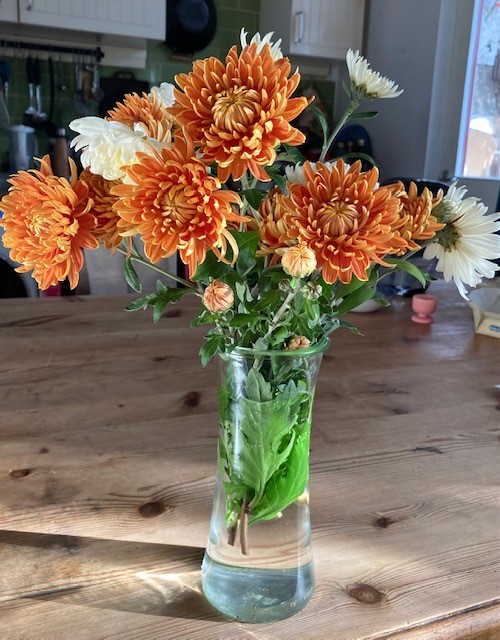
The greenhouse is emptying now, with all of the tender vegetables of summer and autumn well over. The inhabitants from here to spring will be a very different set of plants, not those that need as close to Mediterranean heat as we can give them in this country, as is the case with the aubergines, tomatoes and chillies over the summer and which I have just ripped out, but plants that are most probably hardy enough to survive but will really benefit from a little shelter if and when the weather gets really cold. For those plants that little extra shelter can make all the difference to them performing well next year.
I am about to lift my chrysanthemums and get them ready for a winter under glass.
They are such brilliant plants for late cut flowers, and I haven’t grown them enough. I want to change that and most certainly want to keep the ones I’ve had such success with this year. The first brilliant thing about chrysanthemums is that they flower so late in the year, and they are good and tough and cope well with whatever the autumnal weather throws at them. If you like to grow cut flowers then most of your cut flower patch will be fading by September and pretty much over by November, but chrysanthemums are flowering their hearts out still in November and some even keeping going into December. The second is that they are hardy – you could even leave them out all winter and they are likely to come back, unlike dahlias, the other stalwarts of the late cutting garden, that really should be lifted by now in most gardens. And the third thing is that they are beautiful and productive, being produced in as many colours shapes and sizes as dahlias and pumping out the flowers even as the light fades.
Chrysanthemums are hardy, as I say, and if I didn’t have the greenhouse I could choose to just leave them where they are, but they can suffer from root and stem rotting during cold and wet weather, and will always do better lifted and given a little protection over winter. If I was going to leave them out of doors however, I would cut them back and then cover them with a loose mound of mulch such as wood chippings or the branches of some evergreens (after Christmas, branches of Christmas trees are great for this), just to keep the worst of the cold off.
But digging and potting them up and keeping them somewhere cool and dry like the greenhouse is their best bet for a great start next spring. Cut them back now and pot them into clean compost (spent compost from potted potatoes or tomatoes is fine as your plants wont be growing and so wont need the nutrients found in fresh compost). Water them a little, just to settle the roots in, label them and place them in your greenhouse. Give them a little dribble of water every now and then through winter, but perhaps not during the really cold spells.
When spring comes it is a good idea to keep them in the greenhouse until all danger of hard frost has passed. Start them into growth with a bit more water and bring them on indoors, and then when you do want to plant them out, acclimatise them for a week or two first, taking them outside in the day and then back in at night. Once out in the garden, water freely to get them re-established, and look forward to an autumn full of cut flowers.


